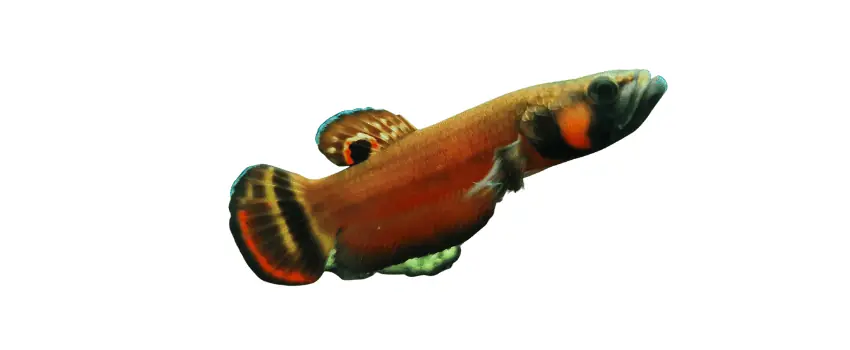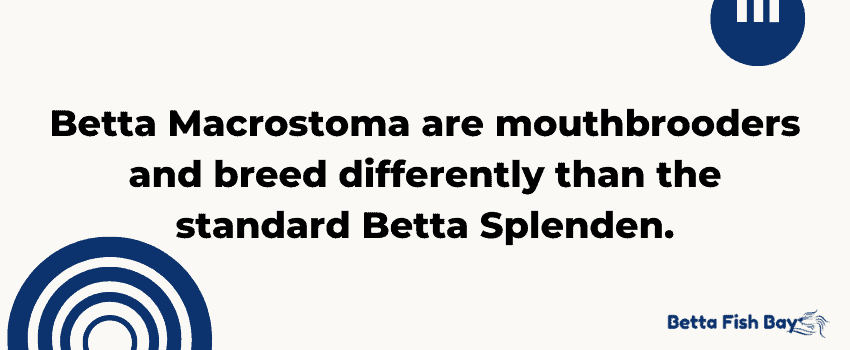Betta macrostoma is a unique betta variety known for its large mouth. The name “macrostoma” translates to “big (macro) mouth (stoma).”
This betta species is native to the Borneo region. This includes Sarawak in Malaysia as well as Brunei.
It’s currently listed as an endangered species by the IUCN Red List, D2. Numerous factors have played a role in this, including pollution and destruction of their natural habitat.
Due to their endangered status, Betta macrostomas cannot be exported from Sarawak. However, you may still buy bettas from the Brunei region.
Table of Contents
Appearance

Betta macrostoma have beautiful orange bodies, sometimes accented with other colors. Some of these colors include red, brown, white, and black.
These bettas have black markings on their fins. Also, they have scaling along their cheeks.
A fascinating feature of this betta species is its fins, which are less prominent than other varieties. They tend to be short and rounded rather than long and flowing.
Finally, Betta macrostomas have large mouths. The males use their mouths during breeding to carry the fertilized eggs until they hatch.
Unique Differences
Betta macrostoma have a couple of unique differences when compared to other betta varieties:
- This species consists of mouthbrooders. This means the males carry fertilized eggs in their mouths after mating. The betta may swallow or spit out the eggs if stressed, and this causes breeding difficulties.
- Betta macrostomas are less aggressive than other betta varieties. For this reason, two males can occasionally be housed together. It’s also common to keep a breeding pair together in the same tank long-term.
Keep these things in mind while caring for and breeding your Betta macrostomas.
Lifespan
The lifespan of Betta macrostomas in captivity can vary widely.
On average, this species of betta lives from three to 5 years in captivity.
The best way to extend your betta’s life is through proper care.
Average Size
Betta macrostomas are a larger variety of betta. They can grow from 3.5-4″ inches in length.
Male bettas tend to grow larger than female bettas.
Feeding your bettas a proper diet is essential in helping them grow to their full potential.
Betta Macrostoma Care
Betta macrostomas are more difficult to care for than many other species. Be diligent in caring for your betta, and follow the advice outlined below.
Tank Size
For a single Betta macrostoma, you will need to buy a 20-gallon tank.
This minimum tank size will ensure your betta has plenty of space to roam. Since this betta species is territorial and larger than most other varieties, this extra space is essential.
Water Parameters
To help your Betta macrostoma thrive, keep the water temperature and other parameters stable.
The recommended parameters for this species of betta are as follows:
Ideal Water Parameters for a Betta Fish Tank Include the following:
- Temperature: 78-80° degrees Fahrenheit (25.5-27° C)
- pH: 6.5-7.5
- Ammonia and Nitrite: 0 ppm
- Nitrate: < 40 ppm
- gH: 3-4 dGH (50-66.7 ppm)
- kH: 3-5 dKH (53.6-89.4 ppm)
- Minimum Tank Size: 5 Gallons
Also, ensure levels of ammonia and other toxins remain close to zero. Especially watch for heavy metals and nitrates, as they can kill your fish.
What To Put In Their Tank
Set your Betta macrostoma up for success with the appropriate tank setup. Here are some things to include in its tank:
Substrate
Include a layer of gravel or substrate at the bottom of the tank. It should be of a neutral color, as bright colors make bettas feel stressed and aggressive.
Also, consider adding leaf litter to the substrate. Leaf litter adds tannins to the water, which will help your Betta macrostoma thrive.
Filter
Install a low-flow filter in the tank.
The filter will keep the water circulating and remove toxins from the water. This will improve water quality and keep water parameters within optimal range.
It’s important to buy a filter with a low-flow design.
This filter style leaves the water mostly undisturbed, which mimics the bettas’ wild habitat. It’s also safer for your betta’s fins, as it poses less danger to its fins.
Heater
Consider installing a heater in the tank for ease of maintenance.
The heater will help keep water temperatures warm enough to support your betta.
This is crucial since Betta macrostomas need specific water parameters to thrive.
Plants
B. macrostomas prefer tanks with plenty of cover, so plants are essential. Putting various plants in the aquarium will remind your betta of its wild habitat.
There are several aquarium plants your B. macrostoma will love:
- Anubias
- Java fern
- Java moss
- Cryptocoryne wendtii
- Guppy grass
- Water sprite
- Frogbit
You may also opt to put artificial plants in the tank.
This is fine as long as you avoid plastic plants. They may have sharp edges, which can damage your betta’s fins.
Instead, choose plants made from safer materials, such as silk.
Hiding Places
B. macrostomas need hiding spots present in their tank.
Betta fish are territorial, and they prefer environments offering privacy.
There are two primary ways to incorporate hiding places into your betta’s tank:
- Add decorations. Most betta tank decorations feature hidey-holes. These are ideal places for your betta to hide away and relax.
- Include driftwood. This is another great option, as the driftwood serves two purposes. It both provides hiding spots for your betta and adds tannins to the water.
Be careful not to overdecorate. Too many decorations can crowd the tank, causing your betta to feel stressed.
A Lid

Betta macrostomas are excellent jumpers.
We recommend buying a high-quality lid for your tank to keep your bettas safe at all times.
Use the tightest-fitting cover possible.
This will keep your bettas from jumping out of the water.
Possible Diseases
B. macrostoma is prone to many of the same diseases as other betta varieties:
- Dropsy
- Swim bladder disease
- Popeye
- Ich
- Tail and fin rot
- Flukes
- Anchor worms
- Betta fish lice
Additionally, this betta variety is susceptible to various fungal infections.
These infections usually result from imbalances in water pH levels.
Here are some tips on how to protect your B. macrostoma from fungal infections and other diseases:
- Perform frequent water changes
- Feed your betta a varied diet
- Treat tank water with conditioner
- Remove uneaten food from the tank
If your betta is ill or stressed, consider taking it to a vet. They can diagnose the issue and suggest the best treatment options.
Keep your bettas healthy with a varied diet, good water quality, and proper attention.
Food & Diet
B. macrostomas need a varied, protein-rich diet to thrive. They are omnivorous, meaning they eat both meat and plants.
Consider feeding your betta a variety of food types:
- Live foods. This food type is high in protein and other nutrients. It also allows your betta to feed according to its natural instincts. Common live foods for B. macrostoma include bloodworms, mosquito larvae, and brine shrimp. Some betta keepers dislike this option due to its high cost and difficulty handling live food.
- Frozen foods. This is another popular option. It provides much of the same nutrition as live foods but is easier to handle.
- Freeze-dried foods. This option is convenient, affordable, and high in nutrition. It also stores well and is widely available.
- Pellets and flakes. B. macrostoma is one variety of betta who doesn’t care for pellets or flakes. Sometimes, they will eat pellets, but we recommend focusing on other food types.
Also, avoid overfeeding your betta.
Betta fish are prone to digestion issues, constipation, and obesity.
Additionally, the accumulation of uneaten food raises ammonia levels. Cleaning up leftover food helps maintain water quality over time.
Behavior & Temperament
B. macrostoma is a more peaceful species than Betta splendens.
However, like all betta species, macrostomas are territorial. They will show aggressive behavior toward other males and need plenty of space.
This species does well in community tanks. But if you notice aggression issues, consider moving your betta to its own separate tank.
Tank Mates
B. macrostoma does well with tank mates in community tanks.
It’s important to only house this betta species with compatible tank mates. These include smaller and less aggressive species, which will not disturb your betta.
Here are a few great betta tank mate ideas:
- Rasbora
- Corydoras
- Otocinclus
- Kuhli Loach
- Tetra
- Cherry Barb
- White Cloud
Also, B. macrostomas are best kept in groups with each other.
These groups should consist of a few males and a few females. This aids with mating, as the bettas naturally form breeding pairs.
Breeding

Unlike Betta splendens, Betta macrostomas are mouthbrooders.
This means they do not build a bubble nest. Rather, the male betta carries the fertilized eggs in his mouth until the fry hatch.
Stress can cause the betta to swallow the eggs by accident. This creates some breeding difficulty, as breeders must keep the betta’s stress levels down.
Keep reading for information on the B. macrostoma mating process.
The Breeding Process
B. macrostomas are often housed together in pairs of one male and one female.
This increases the chances of successful mating, facilitating the natural mating process.
However, setting up a separate tank for breeding is best. This is because the fries, after hatching, will need to live separately from the adult pair.
Here is what to expect from B. macrostoma breeding:
- The male betta will approach the female several times, flaring its fins.
- The betta pair will begin the mating or courtship dance if the female is receptive.
- During the dance, the male releases sperm over the female’s eggs to fertilize them. This is called the spawning process.
- After the mating dance, the male will collect all the fertilized betta eggs in his mouth.
- The incubation period for the eggs is anywhere from 14 to 35 days. Keep both the male and the female in the breeding tank during this time.
- After incubation, the fries hatch, and the male releases them from his mouth.
- At this point, remove the male betta from the separate breeding tank. The fries do not receive parental care.
Ensure a quiet and peaceful environment during breeding.
If the male betta becomes frightened while holding the broods of eggs, he will swallow or spit them out.
Note: Once the fries have hatched, you will need to take care of them. Learn what foods are the best nutrition source for fries in our fry care guide.
Price
This type of betta is rather expensive.
For a single B. macrostoma, you’ll pay anywhere from $75 to $180.
If you’re buying a pair for mating, you may be set back as much as $400.
Rarity
B. macrostoma is a particularly rare variety of betta.
This is due to its endangered status and its breeding difficulty as a mouthbrooding fish species.
In Malaysia, it’s illegal to export any B. macrostomas from the Sarawak region. This measure is to help keep its population levels stable in its natural environment.
In Brunei, it’s still legal to export this betta variety. This is where most available B. macrostomas come from.
Since exportation is the primary way fish sellers get this variety, they’re hard to come across as captive-bred.
B. macrostoma’s rarity makes it a favorite among betta enthusiasts, but it also raises its price.
FAQ
Still have questions about B. macrostomas? Here are answers to the most frequently asked questions.
Why are Betta Macrostomas So Expensive?
The main reason for Betta macrostomas being so expensive is their rarity.
Since this variety is somewhat difficult to breed, they are less readily available to purchase.
Also, exporting this variety from Sarawak in Malaysia is illegal. This makes it even more difficult to find for purchase.
What Size Tank Does a Betta Macrostoma Need?
Betta macrostomas require a minimum tank size of 20 gallons for a single betta.
If you plan on housing a betta pair, opt for a 40-gallon tank. This will give both bettas enough space to ensure their privacy and promote successful breeding.
What Is the Difference Between Betta Channoides and Betta Macrostoma?
Betta channoides tend to be smaller and easier to care for than Betta macrostomas.
Additionally, they have some variations in coloration and patterns.
Channoides have less striping than macrostomas. They also have a red- or rust-colored body, whereas macrostomas have more of an orange body.
Help Your Beautiful Betta Macrostoma Thrive
Your Betta macrostomas deserve the best life possible.
This is why we are dedicated to provided the best and most up-to-date information on betta care.
Follow our website for useful tips, guides, and products.


